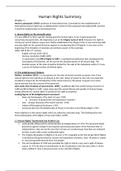Summary
Human Rights summary on the book 'International Human Rights Law'
- Module
- Institution
- Book
Summary for the minor Human Rights. The summary is of the book 'International Human Rights Law. It includes chapters 1, 2, 4, 5, 6, 8, 9, 10, 11, 12, 13, 19, 20, 21, 22, 24, 26, and 27.
[Show more]




